



Safety
Electricity
8A1 Understand that large or high-voltage capacitors can store dangerous electric charges and must be discharged before working on equipment.
Recall that large value resistors can be used to provide leakage paths for these stored charges.
A capacitor has the ability of store a charge equal in voltage to that which is applied to "charge up" the capacitor. Which,if some means to discharge the capacitor, such as a "bleed" resistor, does not exist, the capacitor might well stay charged for a long time until natural leakage of the charge occurs. A bleed resistor is one which has a large value of resistance and is permanently connected across the capacitor terminals. If the voltage is 230V then the shock you would get from it would be the same as a mains electric shock. The danger would be even greater if it was a high voltage capacitor and a high value capacitor as the discharge would be immense.
Even a high value capacitor at low voltage say 12V could do a lot of damage it say a screw driver fell across it. It would be like a welding flash and probably burn the screw driver in half.
8A4 Recall that equipment mains fuses may be of a special type, such as quick blow or slow blow to allow for an initial surge of current and that the specified type must be fitted.
Understand that a fuse must be correctly rated for proper
protection, and, in the absence of manufacturer’s
instructions, to select an appropriate fuse.
For mains: current = power/230 where 230 is the nominal mains
voltage.
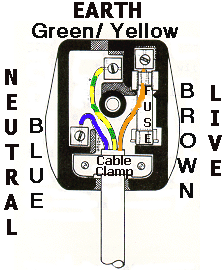
In the UK the nominal mains voltage is 230V AC.
Whilst you have not been asked to calculate the current rating of a fuse before - you are now. However this is only the most basic of calculation and to the purest it would not be considered correct but for the course you use the equation :-
So if you had a 230w bulb the bulb would be said to have an INPUT POWER of 230W.
Thus from the calculation current = power divided by voltage you get 230/230 = 1 amp. out of the choice of fuse 3,5 or 13 amp you would chose 3amp
Again if it was input power of 2300W fire you would use a 2300/230 = 10 amps you would then have to use a 13 amp fuse.
Now in the exam you will not be likely to have such easy calculation but the method is the same :-
fuse rating = power divided by the mains voltage of 230V
To re-cap mains plug fuses in UK come in three current ratings 3, 5 and 13 amps. The fuse rating that you chose will be the one which is just higher than the calculated value of the input current which has been worked out from the input power.
8A6 Understand that working on live equipment must only be done if it is not practicable to do otherwise and if the risks and appropriate precautions are fully understood.
It is not recommended to work on live equipment for fear of electric shock which can kill you. Never ever put your hands near live mains a.c. cables or circuitry. Should you need to read if mains voltage is getting through, you can measure it wearing insulated safety gloves and using a multimeter with long high voltage probes. Similarly you should not work on high voltages inside receivers or transmitters without similar precautions. You must understand that you make these measurements after checking for all possible risks then being ultra careful when making the measurements
8A8 Understand that vehicle batteries are a
source of very high currents which can start a fire and that
battery contents are corrosive.
Understand that explosive hydrogen gas can be given off when
charging batteries and that ample ventilation is required.
A vehicles battery can store a very high charge due to the fact a lot
of energy is required to start a vehicle's engine. This energy is
stored between plates inside the battery which are immersed in a
corrosive chemical. So measures must be taken if using such a battery
for amateur radio use. They are usually quite heavy and so you should
protect it from damage and also so it cannot be dropped and cause an
acid spillage. When connecting it up to your portable equipment make
sure you do not short the terminals because the high energy current can
all be released at once casing melting of metals such as wires, which
can also catch fire.
When charging your vehicle battery it may give
out fumes of hydrogen and oxygen which if exposed to a naked flame or
spark could explode and cause a lot of damage. The answer is to charge
your vehicle battery in a well ventilated area.
Using tools
8B2 Understand that screwdrivers, drills,
saws and files must be handled with care.
Understand that fingers should always be behind the blade of
hand tools.
![]() "Why do we have to understand
the dangers of hand tools ?" - Asked a student the other
evening. The answer is that the possibility of carrying out
construction of your own equipment, even in a small way is
now becoming a practicality, so
this is a general introduction to the dangersof
the most common of tools etc that might be used.
"Why do we have to understand
the dangers of hand tools ?" - Asked a student the other
evening. The answer is that the possibility of carrying out
construction of your own equipment, even in a small way is
now becoming a practicality, so
this is a general introduction to the dangersof
the most common of tools etc that might be used.
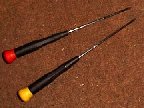
Even the humble screwdriver could cause up injury is it slips out of a screw head and hits your hand, for instance, so always consider what could happen and avoid accidents.

With the drill it is a little more obvious that injury could occur as a drill is intended to cut but ensure that it cut in the right place - such as a hole through metal wood etc.

Again the saw is intended to cut so make sure it is only the piece that you are working on the is cut. Even a small saw like this one has a very sharp blade and with the small teeth can easily cut into your fingers etc !!!

Few people know about the damage that a file can cause if it does not have a proper handle. The handle end if a file has a pointed "tang" which is inserted into a handle and should the handle become detached and the operator uses the file with the handle they risk stabbing their hand with the file's tang. The file with its handle attached is shown in the picture below. Be aware that sometimes is the handle is wooden that it can dry out and slip off the tang leading to danger!!

Remember to keep all actions where there is a chance of impact with hand, face or any other part of the body under proper control.
8B3 Understand that any items being drilled, sawn or filed must be securely held in a vice or similar device to prevent them slipping or rotating.
So that injuries are kept to a minimum, all items that are to be worked upon must be properly held so that they will remain held until the action that it carried out on them is completed.
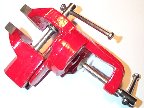
Dangers occur when items can slip or rotate.
The picture shows a small vice which is suitable for carrying in your tool box and fixing to a bench top (with suitable protection against scratching !!)
8B4 Understand that any locking keys, and/or chuck keys, must be removed before using a power tool such as a drill to prevent the key being ejected at high speed.

Many electric drills have what is called a chuck key. This is used to lock a drill bit into the chuck prior to drilling a hole. If the drill is started before the chuck key is removed then there is a great danger that the key will fly out, at high speed, and could impact any where and if this is with your body great injury could result.
8B5 Understand that using a centre punch will help prevent a drill bit slipping.

There is a simple tool called a centre punch which can greatly reduce the chance of a drill bit slipping on a material you want to drill.
By placing the tip of the punch on the point where you wish to drill a hole and smartly hitting the other end with a hammer a small indentation is formed that will "start" the drill in the right place and reduce slipping.
8B6 Understand the reasons why a bench-mounted pillar drill is safer than a hand-held drill.
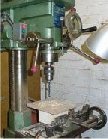
The hand drill is prone to moving about whilst you are drilling particularly large holes in thin metal. Thus it is much safer to use a pillar drill which holds the cutting drill steady and so long as the piece being drilled is held still the risk of injury is much reduced.

When drilling, especially metal, chipping called swarf, which are small particles, are thrown off and these would particularly cause eye damage. The risk is even greater when drilling brass as brass being none magnetic, if you did get swarf in your eye the surgeon could not use a magnet to help recover the swarf, which they might do with some steels which are magnetic.
IMPORTANT Information regarding Soldering

A soldering iron bit is the hot part and the stand is the relatively cool part. A soldering stand is used when the soldering iron is not in use to try to avoid contact between the soldering iron bit and your skin which would be readily burned.
The temperature of the soldering bit may reach 400C or even higher!
There are parts of even the soldering iron stand which get hot namely the spring,if the stand has one, into which the iron is placed. This spring also acts as a heat sink to take away heat from the tip and reduce decay and thus increases the life of the tip.
Also keep the cleaning pad in the stand damp - not soaking wet - so that you can readily clean the tip of the soldering iron.
NEVER have WATER near by when you are using mains electricity
** Keep that coffee cup away from your work area. **
When soldering fumes are given off from electronic solder which is a special type of solder which is called "cored" solder. The core holds the "flux" which enhances the cleaning of the surfaces to be joined. The flux when it becomes hot burns and gives off a vapour which should not be inhaled as there is the possibility of it causing breathing problems including asthma.
Eye protection must be worn when soldering to prevent solder from splashing into the eyes.

Both the flux and the solder is at very high temperature and both can spit if the surface of the board is damp due to the fact that the water quickly turns to steam and when mixed with the flux or solder created minor explosions or spitting.
Flux and solder must NOT be allowed to reach your eyes, else damage could occur so the wearing of protective goggles is necessary.
Working at heights
A ladder should be used at the correct angle (4:1 height-to-base ratio).

When working on a ladder to put up antennas etc remember the golden rule is 1 out for 4 up.
How ever you want to remember it:- the golden rule is "1 out for 4 up".
Ladders must be secured at the top or securely held at the bottom by an adult to prevent the ladder from slipping.
When you are up a ladder, you have the chance to fall off if the ladder moves. Thus tie the ladder firmly at the top so that it cannot move and whilst doing that have an adult who knows what they are doing holding it at the bottom. Better still get two adults to make the ladder as safe as possible and let them do the necessary work - less fun but safer!
When you are on a ladder remember another golden rule :-
"Always have three limbs in contact with the ladder"
that will prevent you from over reaching. If you do over reach a ladder at least two things could happen:-
you fall off or
the ladder turns round and you end up on the under side wondering what on earth happened and thinking what you are going to do next.
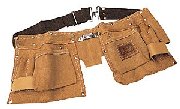
When working above ground level it is good practise to use some form of tool belt to hold tools that you are going to use. It means that the tools are :
to hand
are not left after you have come down
helps prevent them be knocked off a resting place down to the ground with the possibility of hitting the person holding the ladder !!
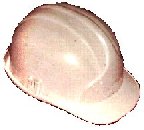
Now a hard hat is not a fashion accessory but it is an absolute necessity when working above ground or when you are standing below someone working overhead.
A falling tool would have a distinct possibility of cracking your skull if hit by a large spanner of hammer falling from above you.
Worth remembering:-
A dangerous electric shock can result from antennas and ladders coming into contact with or arcing from overhead lines.
You were introduced to dangers associated with electricity (mains) and (RF) in the Foundation Licence and whilst normally it is our friend to power our radios there is the danger of electric shock which can result from antennas and ladders coming into contact with or arcing from overhead lines. The potential arcing to occur is due to the ladder being at lower potential, that of the ground, than the voltages being carried by the wires and for the potential desire to flow into the lower level.
So don't try to erect :-
a metal mast right underneath a power line nor
try to tie an antenna to an overhead power cable or its support nor
work near an antenna wire which might be in use and the operator not know you are in the vicinity
Working with RF
8D1 Recall that at 100W transmit power, especially with higher gain antennas, the EMF compliance distance can be several metres.
Should you have been operating your transceiver then you have been using electromagnetic radiation. In fact when you have been listening to the broadcast radio, watching the television or even cooking in your microwave cooker you have been using electromagnetic radiation one way or another. Electromagnetic wave is just a fancy way of saying radio waves but there are also many other wave that have names within the range of electromagnetic radiation as shown in the diagram below.

You can see now the change in frequency from say 1MHz at the radio to many many many Mhz at the gamma ray end. Note also the portion of the microwave just above radio and below infrared. Infrared is heat rays and microwave cooker do just that with slightly lower frequencies.
The only difference in the waves is their wave length.

So now you understand that electromagnetic radiation is the point here is to know that the main health effect of electromagnetic radiation is heating of body tissue just like you cook in a micro wave. Thus do not touch an antenna when in use and also do not get too near to them.
For EMF field safety reasons we now have a calculator in the form of a spreadsheet, available from the RSGB, where we can enter the type of aerial, its height, band, and the power transmitted to give us the emf field value at a certain distance. We also have to be able to prove that we know what is this safe distance by running the spreadsheet and saving the results. This is detailed on the very first page of our training website. So should your emf field be nearer to you or any of your neighbours than allowed, then you should not transmit until you satisfy the regulations.
Guidance on safe levels of RF radiation is available from government and international bodies (HPA - Health Protection Agency and ICNIRP International Committee on Non-Ionising Radiation Protection).
Booklets can be obtained that give information as to what are considered "safe" radiation levels. Such booklets are available from government and international bodies (HPA and ICNIRP).
The HPA Agency (Health Protection Agency) was established as a non-departmental public body, replacing the National Radiological Protection Board (HPA) and with radiation protection as part of health protection incorporated in what is has to control.
So be aware that this change may not have filtered through to all training courses.
Recall that, when mobile, pedestrians might be
inside the EMF compliance distance.
Recall that in such situations, especially
when stationary, transmission must cease.
When operating mobile, be aware that pedestrians can come and go and maybe enter inside your emf field. In order to prevent any safety hazard by them getting rf burns from touching your antenna or of them having any body tissue heating then you must stop transmitting until it is safe to do so again.
Lightning
8E1 Recall that limited protection of equipment against the build-up of static charge can be obtained from gas discharge arrestors, spark gaps and bleed resistors.
We know lightning is a very powerful force of nature and that power is shown when lightning flashes occur. We would not like this energy to hit our homes or come down our antenna and destroy all our delicate equipment but this has happened. Just having lightning near by, we can have induced static energy build up in our antennas which can also damage our radio equipment. Some of this energy build-up can be partly discharged with devices called gas discharge arrestors, bleed resistors and spark gaps to get the charge to ground. However this is not a total solution. In a lightening storm, even if only nearby, it is best to switch off all equipment and disconnect your antennas from that equipment so that lightening has no path to the ground.
A safety question from a student -
What is a waveguide please ? asked one student the other night. So here is the answer:-
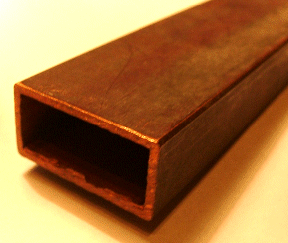
The photograph shows a section of "Waveguide". This piece has no flange on the end to join it to the next piece or to what would look like a rectangular funnel or horn as the end of a microwave antenna is called.
The waveguides are used in microwave transmissions lines. Unlike "normal" coaxial antenna the waveguide looks like the end of a flattened pipe and the microwaves shoot out of them usually into a dish or some other radiating antenna - just like a bullet comes out of a gun or water out of a hose.
So looking down a wave guide would be just like looking down the barrel of a gun and could be just as dangerous!!
To see some more waveguide click here.
Hi-gain antennas
Hi-gain antennas are yagis where the RF is being concentrated in one direction (for the most part) and thus it is unwise to stand in front or near to the side off a yagi as the ERP will be several times as great as the power being fed to the antenna.
Further the higher the frequency the greater the risk.
Note Yagis are usually fed by coaxial feeder and thus are not to be associated with wave guides as a feeder to them.
So stand clear of ALL yagis and especially those at higher frequencies.
You have reached the end of the Intermediate course! Well done!
Why not take our self-assessment test to see if you have understood well. Use the button below.
The origin of some of the text on this page is from the RSGB with additions by the web master